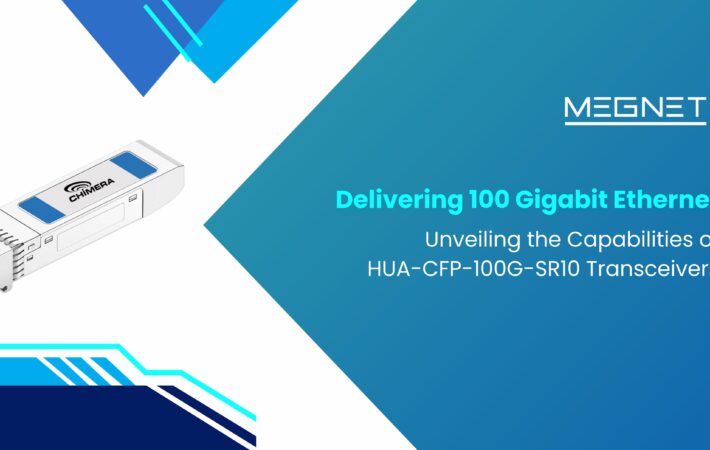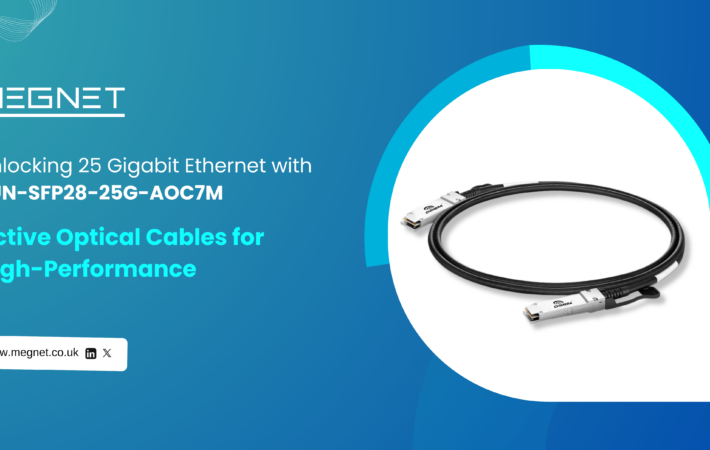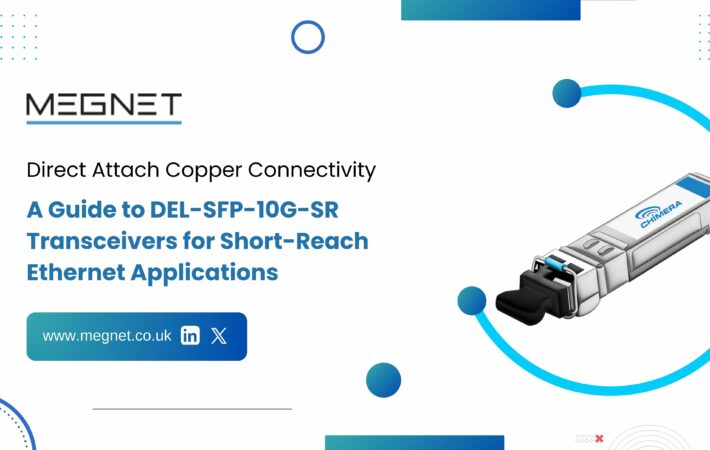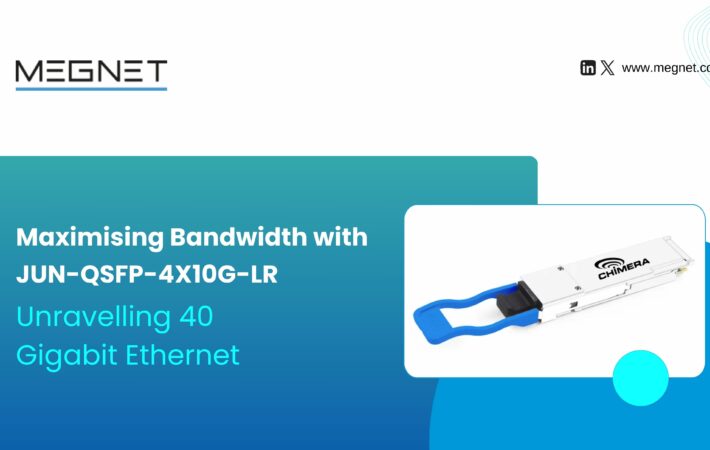
Scaling New Heights: ARI-QSFP+ 100G for Cloud Computing in Telecom
The rapid evolution of cloud computing and telecommunications has necessitated advancements in network infrastructure, bandwidth, and data transfer technologies. Among the critical innovations steering this growth is the ARI-QSFP+ 100G, a high-speed, high-efficiency transceiver module designed for modern data centres and telecom applications. This blog delves into the transformative impact of ARI-QSFP+ 100G on cloud computing in the telecom industry, exploring its technical specifications, benefits, and potential future developments.
Introduction to ARI-QSFP+ 100G
The ARI-QSFP+ 100G, or Quad Small Form-factor Pluggable Plus, is a high-speed optical transceiver used in data communication and telecommunication networks. It supports 100 Gigabit Ethernet (100GbE), making it a crucial component in meeting the ever-growing demands for higher bandwidth and faster data transmission speeds in cloud computing environments.
The Rise of Cloud Computing in Telecom
Cloud computing has revolutionized the telecommunications industry by enabling scalable, flexible, and cost-effective solutions. Telecom companies are increasingly leveraging cloud infrastructure to enhance their service offerings, streamline operations, and provide innovative solutions like Network Functions Virtualization (NFV) and Software-Defined Networking (SDN). The surge in data consumption, driven by video streaming, IoT devices, and mobile data, necessitates robust and efficient networking solutions, where ARI-QSFP+ 100G plays a pivotal role.
Technical Specifications of ARI-QSFP+ 100G
The ARI-QSFP+ 100G transceiver is packed with advanced features that make it suitable for high-speed data transmission. Key specifications include:
- Data Rate: Up to 100 Gbps, allowing for high-speed data transfer required by modern cloud applications.
- Reach: Supports varying distances, typically up to 10 km for single-mode fiber (SMF) and shorter distances for multi-mode fiber (MMF), depending on the specific module.
- Interface: Utilizes a 38-pin connector for ease of integration into existing network equipment.
- Form Factor: Compact and hot-swappable, facilitating easy upgrades and maintenance without disrupting network operations.
- Power Consumption: Designed to be energy-efficient, typically consuming less than 5 watts, which is crucial for reducing operational costs in large data centres.
- Compatibility: Supports multiple protocols, including Ethernet and InfiniBand, ensuring versatility across different networking environments.
Benefits of ARI-QSFP+ 100G in Cloud Computing
High Bandwidth Capacity: The primary advantage of ARI-QSFP+ 100G is its ability to handle vast amounts of data at high speeds. This capability is essential for cloud data centres that need to support numerous simultaneous data streams, ensuring smooth and uninterrupted services.
- Scalability: As telecom companies expand their cloud services, the need for scalable network solutions becomes evident. ARI-QSFP+ 100G modules allow for easy scaling of network capacity, accommodating growth without requiring significant infrastructure changes.
- Low Latency: In cloud computing, low latency is critical for real-time applications such as VoIP, video conferencing, and online gaming. ARI-QSFP+ 100G minimizes latency, providing faster data transmission and improving user experiences.
- Energy Efficiency: With growing concerns about energy consumption and environmental impact, the ARI-QSFP+ 100G’s low power consumption is a significant benefit. It helps telecom companies reduce their carbon footprint and operational costs.
- Reliability and Redundancy: High reliability and built-in redundancy features ensure that cloud services remain available even during hardware failures. This reliability is vital for maintaining service level agreements (SLAs) and ensuring customer satisfaction.
- Cost-Effectiveness: Although the initial investment in 100G infrastructure can be significant, the long-term benefits, including reduced operational costs and increased efficiency, justify the expenditure. The ARI-QSFP+ 100G modules are designed to offer a good return on investment by improving overall network performance.
Real-World Applications
To understand the practical impact of ARI-QSFP+ 100G, let’s look at some real-world applications and case studies:
- Telecom Cloud Data Centres: Major telecom operators are deploying ARI-QSFP+ 100G modules in their cloud data centres to manage the growing data traffic and enhance their service offerings. For example, a leading telecom company upgraded its infrastructure to support 5G rollout, utilizing ARI-QSFP+ 100G to ensure high-speed data transfer and low latency.
- Content Delivery Networks (CDNs): CDNs rely on fast, efficient data transmission to deliver content to users worldwide. By implementing ARI-QSFP+ 100G, CDNs can significantly reduce load times and improve user experiences, particularly during high-traffic events such as live streaming or software updates.
- Enterprise Cloud Solutions: Enterprises migrating to cloud-based solutions require robust network infrastructure to support applications like enterprise resource planning (ERP) and customer relationship management (CRM). ARI-QSFP+ 100G provides the necessary bandwidth and reliability to handle these complex applications.
Future Trends and Developments
The future of ARI-QSFP+ 100G in cloud computing and telecom is promising, with several trends and developments on the horizon:
- Integration with 5G Networks: As 5G networks become mainstream, the demand for high-speed, low-latency connections will grow. ARI-QSFP+ 100G is expected to play a crucial role in supporting the backhaul infrastructure required for 5G, enabling seamless connectivity and faster data transmission.
- Advancements in Optical Technologies: Continuous improvements in optical technologies are expected to enhance the capabilities of ARI-QSFP+ 100G modules. Innovations such as coherent optics and advanced modulation techniques could increase data rates and extend transmission distances, further boosting network performance.
- AI and Machine Learning Integration: Artificial intelligence (AI) and machine learning (ML) are increasingly being integrated into network management systems. These technologies can optimize the performance of ARI-QSFP+ 100G by predicting and managing traffic loads, identifying potential issues before they affect the network, and ensuring optimal resource allocation.
- Enhanced Security Features: With the growing importance of data security, future iterations of ARI-QSFP+ 100G modules may incorporate enhanced security features to protect against cyber threats. This includes advanced encryption techniques and secure boot processes to safeguard data integrity.
- Sustainability Initiatives: As sustainability becomes a key focus for many organizations, ARI-QSFP+ 100G modules will likely evolve to become even more energy-efficient. This aligns with global efforts to reduce carbon footprints and promote environmentally friendly practices.

The ARI-QSFP+ 100G Ecosystem
To fully appreciate the impact of ARI-QSFP+ 100G, it is essential to understand its place within the broader ecosystem of network infrastructure. This ecosystem includes various components such as switches, routers, servers, and storage devices, all of which must work seamlessly together to ensure optimal performance.
Interoperability and Integration
One of the key advantages of ARI-QSFP+ 100G is its high level of interoperability with existing network infrastructure. This transceiver module is designed to be compatible with a wide range of network equipment from different manufacturers, facilitating easy integration and reducing the need for costly infrastructure overhauls. This compatibility ensures that telecom operators can upgrade their networks incrementally, minimizing disruption and maximizing return on investment.
Enhanced Network Management
Advanced network management features are integral to the functionality of ARI-QSFP+ 100G. These features include remote monitoring and diagnostics, which allow network administrators to keep track of performance metrics and identify potential issues before they escalate into serious problems. This proactive approach to network management helps in maintaining high levels of service availability and reliability, which are critical in cloud computing environments.
Addressing Challenges with ARI-QSFP+ 100G
Despite its numerous advantages, the deployment of ARI-QSFP+ 100G also presents several challenges that need to be addressed to maximize its benefits.
- Managing Increased Complexity
As network speeds and capacities increase, so does the complexity of managing these networks. ARI-QSFP+ 100G, while simplifying some aspects of network scaling, also introduces new layers of complexity. Effective management tools and skilled personnel are essential to ensure that the network operates smoothly and efficiently.
- Cost Considerations
The initial investment required for deploying ARI-QSFP+ 100G can be substantial, especially for smaller telecom operators. However, it is important to consider the long-term benefits and cost savings associated with improved performance, energy efficiency, and scalability. Careful financial planning and phased implementation strategies can help mitigate these costs.
- Heat Dissipation and Power Consumption
As network equipment becomes more powerful, managing heat dissipation and power consumption becomes increasingly important. Although ARI-QSFP+ 100G is designed to be energy-efficient, large-scale deployments can still generate significant heat. Implementing effective cooling solutions and optimizing power usage are critical to maintaining the performance and longevity of network equipment.
The introduction of ARI-QSFP+ 100G has spurred a wave of innovations in both hardware and software, driving the telecommunications industry forward.
- The development of ARI-QSFP+ 100G has led to significant advancements in optical networking hardware. For instance, the design of more compact and efficient transceiver modules has allowed data centres to increase their port densities, thereby maximizing the use of physical space and reducing overall costs.
- Software-Defined Networking (SDN) has emerged as a key technology in modern network management, providing greater flexibility and control over network resources. The high bandwidth and low latency capabilities of ARI-QSFP+ 100G make it an ideal component for SDN environments. By decoupling the control plane from the data plane, SDN allows for dynamic network configuration, optimising performance and resource utilization.
- Network Functions Virtualization (NFV) leverages virtualized network services to replace traditional hardware-based appliances. ARI-QSFP+ 100G enables the high-speed data transfer required for NFV, supporting the deployment of virtual network functions (VNFs) and enhancing the agility and scalability of telecom networks.
The Future of ARI-QSFP+ 100G in Telecom and Cloud Computing
Evolution Towards 400G and Beyond
While ARI-QSFP+ 100G represents a significant leap forward in data transmission technology, the industry is already looking towards the next generation of transceivers, including 200G and 400G modules. These advancements promise even higher data rates, further reducing latency and increasing the capacity of network infrastructure.
Integration with Artificial Intelligence and Machine Learning
The integration of AI and ML into network management systems will play a crucial role in the future of ARI-QSFP+ 100G. These technologies can analyse vast amounts of network data to predict traffic patterns, detect anomalies, and optimize resource allocation in real-time. This level of intelligence will be essential for managing the increasingly complex and dynamic networks of the future.
Enhanced Security Measures
As cyber threats continue to evolve, so too must the security measures embedded within network components. Future iterations of ARI-QSFP+ 100G transceivers will likely include advanced security features such as end-to-end encryption, secure firmware updates, and real-time threat detection to protect sensitive data and maintain the integrity of network operations.
The Impact of ARI-QSFP+ 100G on Cloud Service Providers
Cloud service providers (CSPs) are at the forefront of the digital revolution, offering a variety of services such as Infrastructure as a Service (IaaS), Platform as a Service (PaaS), and Software as a Service (SaaS).
The adoption of ARI-QSFP+ 100G transceivers significantly enhances the capabilities of CSPs, enabling them to offer faster, more reliable services.
Improving Data Centre Interconnect (DCI)
Data Centre Interconnect (DCI) is a critical component of cloud service infrastructure, allowing data centres to connect and share resources efficiently. The high bandwidth and low latency offered by ARI-QSFP+ 100G transceivers are essential for DCI, ensuring seamless data flow between data centres. This interconnectivity enhances redundancy, disaster recovery, and load balancing, providing a robust foundation for cloud services.
Enhancing Virtualisation and Cloud Networking
Virtualization technology, which underpins cloud computing, benefits immensely from high-speed networking solutions. ARI-QSFP+ 100G facilitates faster data movement between virtual machines (VMs) and storage systems, optimizing the performance of virtualized environments. This improvement is particularly beneficial for applications requiring high throughput and low latency, such as big data analytics, artificial intelligence (AI), and machine learning (ML).
Supporting Multi-Cloud and Hybrid Cloud Environments
The trend towards multi-cloud and hybrid cloud environments is growing, as organizations seek to leverage the best features of different cloud providers and on-premises infrastructure. ARI-QSFP+ 100G transceivers provide the high-speed connectivity needed to integrate these diverse environments seamlessly. This capability allows businesses to adopt flexible cloud strategies, optimizing costs, performance, and security.

As the telecom industry evolves, new networking technologies are emerging, promising to further enhance the capabilities of ARI-QSFP+ 100G transceivers.
- 5G and Beyond – The deployment of 5G networks is transforming telecommunications, offering unprecedented speeds, low latency, and high device density. ARI-QSFP+ 100G plays a crucial role in supporting the backhaul infrastructure of 5G networks, ensuring that the increased data traffic generated by 5G can be efficiently managed. Looking forward, the transceiver will also be vital in the development of 6G networks, which are expected to push the boundaries of speed and connectivity even further.
- Edge Computing – Edge computing is gaining traction as a means to process data closer to its source, reducing latency and bandwidth usage. The high-speed capabilities of ARI-QSFP+ 100G are essential for connecting edge devices to central data centres, facilitating real-time data processing and analytics. This connectivity is crucial for applications such as autonomous vehicles, smart cities, and industrial IoT, where immediate data processing is required.
- Quantum Networking – While still in its infancy, quantum networking promises to revolutionize data transmission by leveraging the principles of quantum mechanics. ARI-QSFP+ 100G, with its advanced optical technology, lays the groundwork for integrating quantum networking components, paving the way for future innovations in secure and efficient data transmission.
Environmental and Economic Implications
The deployment of ARI-QSFP+ 100G transceivers not only enhances technological capabilities but also has significant environmental and economic impacts.
- Reducing Energy Consumption
Energy efficiency is a critical consideration for data centres and telecom networks, both from a cost and environmental perspective. ARI-QSFP+ 100G transceivers are designed to consume less power compared to previous generations, contributing to lower energy bills and reduced carbon footprints. This energy efficiency aligns with global sustainability goals, helping organizations meet regulatory requirements and corporate social responsibility (CSR) objectives.
- Lowering Operational Costs
While the initial investment in ARI-QSFP+ 100G technology can be high, the long-term operational savings are substantial. Reduced power consumption, enhanced reliability, and lower maintenance requirements all contribute to cost savings. Additionally, the scalability and flexibility of these transceivers enable telecom operators to adapt to changing demands without significant additional expenditure.
- Facilitating Economic Growth
By enhancing the performance and reliability of telecom networks, ARI-QSFP+ 100G transceivers support economic growth. Improved connectivity enables businesses to operate more efficiently, fosters innovation, and opens up new markets. In emerging economies, robust telecom infrastructure can drive digital transformation, contributing to socio-economic development.
Challenges and Considerations for Deployment
While the benefits of ARI-QSFP+ 100G are clear, there are several challenges and considerations that organizations must address to ensure successful deployment.
- Compatibility and Standards – Ensuring compatibility with existing network equipment and adhering to industry standards are crucial for the seamless integration of ARI-QSFP+ 100G transceivers. Organizations must carefully assess their current infrastructure and work with vendors to ensure that new components will operate effectively within their existing systems.
- Skilled Workforce – The deployment and management of advanced networking technologies require a skilled workforce. Organizations must invest in training and development programs to equip their staff with the necessary knowledge and skills. Partnering with experienced vendors and consultants can also help bridge any gaps in expertise.
- Security Considerations – As networks become more complex and data traffic increases, security becomes a paramount concern. Organizations must implement comprehensive security strategies to protect their networks from cyber threats. This includes encryption, access control, and continuous monitoring to detect and respond to potential vulnerabilities.
Conclusion
The ARI-QSFP+ 100G transceiver is a cornerstone of modern telecom and cloud computing infrastructure, offering unparalleled speed, scalability, and efficiency. Its role in enabling high-bandwidth, low-latency connections is critical to the success of contemporary data centres and telecom networks.
As cloud computing continues to expand and evolve, the importance of robust, high-performance network infrastructure cannot be overstated. The ARI-QSFP+ 100G transceiver, with its advanced features and capabilities, is well-positioned to meet the demands of this dynamic industry, driving innovation and ensuring that telecom companies can deliver the high-quality services their customers expect.
By embracing the ARI-QSFP+ 100G and staying ahead of technological trends, telecom operators can not only enhance their current offerings but also lay the groundwork for future advancements in network technology. In doing so, they will be well-equipped to navigate the challenges and seize the opportunities presented by the ever-evolving digital landscape.
FAQ's
Yes, ARI-QSFP+ 100G is designed for interoperability with various network equipment.
Compatibility with your network equipment, reach distance needed (single-mode vs. multi-mode fiber), and any specific features required.
They are hot-swappable, simplifying maintenance. Regular cleaning of dust and debris might be necessary.
No, data loss shouldn't occur during the switch if implemented correctly. However, proper data backups are always recommended during any network upgrades.
Yes, reach depends on the fiber type. Single-mode fiber typically supports longer distances compared to multi-mode fiber.
It supports 5G backhaul and is a foundation for future developments like edge computing and quantum networking.
It improves Data Centre Interconnect (DCI) and virtualization for faster, more reliable cloud services.
Basic troubleshooting steps might involve checking for loose connections, cleaning transceiver ports, verifying cable integrity, and consulting device logs for error messages.
AI-powered network management tools can analyze network data, predict traffic patterns, and automate tasks associated with optimizing performance and identifying potential issues with ARI-QSFP+ 100G deployments.









Leave a comment
Your email address will not be published. Required fields are marked *